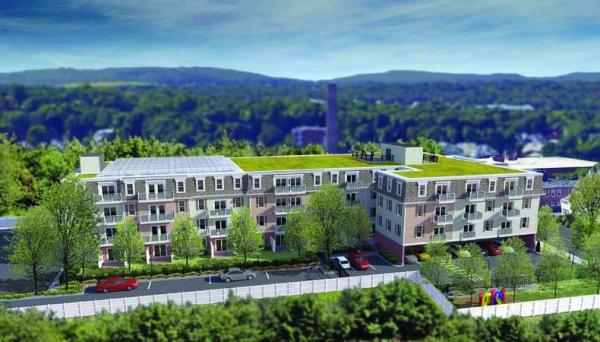March 1, 2018

A rendering shows what the proposed new building at 1120-1132 Washington St. in Lower Mills might look like.
Image courtesy Epsilon Associates, Inc.
57 Condos, two stores would replace three houses on Washington St.
Tempers flared among the more than 50 residents who showed up to a public meeting on Monday night at Carney Hospital to discuss a proposed four-story condominium complex at 1120-1132 Washington Street in Lower Mills. The developer, City Point Center, LLC, intends to build a structure housing 57 residential units with two ground-level retail units on the site, which is currently home to three houses, including the former Molloy’s funeral parlor.
Attendees voiced a range of objections to the project, from concerns about parking and traffic to uncertainty about who is actually financing the proposal, which is currently in the middle of an Article 80 “large project” review from the Boston Planning and Development Agency (BPDA). In documents filed with the city last year, the proponents said that they intended to sell the units as condos, but still reserve the right to convert the project into a rental apartment complex instead.
The Boston Landmarks Commission is set to review the proposal at a public hearing on March 13 at 6 p.m. at Boston City Hall. The three existing structures on the project site along Washington Street were constructed between the mid 18th and mid 19th century, but none are currently listed on the city’s historic register. The commission is required to consider their significance as part of the city’s review process. At Monday’s meeting, representatives for City Point, LLC — including their attorney and an architect—showed the public three “alternative” designs for their new building project if the existing buildings were kept in place.
The first would leave the three existing structures intact, while building on the land behind them— a design that would add two additional floors to the new building. The second alternative would see only the center of the three existing buildings— the funeral home— demolished. A driveway would take the place of this structure, connecting the complex to Washington Street. The third alternative would relocate 1126 Washington St. to the left side of the plot so that the condominium complex could be constructed around it.
Several residents at the meeting expressed opposition to the various alternatives, deeming none of them to be viable options. As the meeting segued into a Q&A about the original proposal, a number of people raised questions surrounding the size of the project and the impact it would have on parking and traffic in a neighborhood already dealing with heavy volume at peak periods.
The original proposal would provide 63 residential parking spaces for the 57 units for a parking ratio of 1.1 per unit, a figure below the 1.5 standard required by existing zoning regulations. One resident said he was worried a dearth of parking spaces would see him lose his street parking spot on Washington Street.
The results of a traffic study presented by the development team did little to assuage these concerns. According to the study, the new development would add 22 new “vehicular trips” to each rush hour period, a figure that would have a negligible impact on traffic volume. The study also assessed nearby intersections and concluded that while some received a “D” or “E” grade, none were considered to be failing by city standards.
As the meeting progressed, more and more residents aired frustrations about the housing proposal process, which has been in the works for about four years now.
“Are they really listening to us?” asked one resident, who said her house abuts the location. “You said they came and spoke to abutters, but no one came to me and spoke to me.”
In an October 2016 meeting, the Lower Mills Civic Association voted 12-9 to support the project. Developers had gone back and forth with civic members on the site plans for about two years before the vote, with primary concerns involving parking, traffic, and density.
An Impact Advisory Group— a select group of neighbors appointed by the BPDA to meet with the proponents— will meet again in mid to late March, according to BPDA spokesperson Bonnie McGilpin. A second community-wide meeting will be scheduled after the IAG meets, she said. Comments on the project may be submitted to the BPDA until March 9.
“The IAG role will remain the same,” McGilpin said in an e-mail. “To advise the BPDA in both identifying the impacts and determining the appropriate mitigation.”


